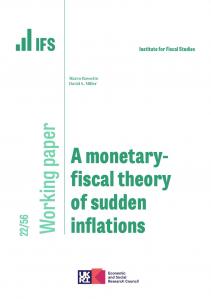Since 2010, when the Office for Budget Responsibility (OBR) has presented the government with a windfall – i.e. improved public finance forecasts – successive Chancellors have tended to spend the majority of it, mainly by topping up their spending plans. But when public finance forecasts have got worse, Chancellors have tended to accept higher borrowing, rather than announce offsetting tax rises or spending cuts. The result was tens, if not hundreds, of billions of additional borrowing over the 2010s, and a bigger state than originally planned.
Given the inevitability of future shocks and revisions to forecasts, continued behaviour of this sort will lead to a continuing upward ratchet in spending, borrowing and debt. It also means that official ‘central’ forecasts cannot really be thought of as central. Irrespective of anything else, if future Chancellors continue to behave like their predecessors, and shocks come along like they did during the 2010s, then we estimate that an appropriate central forecast for borrowing in 2027–28 would be 3.1% of GDP, rather than 1.7% under the OBR’s forecast – around £40 billion higher. Our simulations, based on Chancellors’ decisions since 2010, suggest that there is a nine-in-ten chance that borrowing turns out higher than the OBR forecast.
These are among the findings of new research from the Institute for Fiscal Studies, published today as a pre-released chapter of the 2023 IFS Green Budget, produced in association with Citi and with funding from the Nuffield Foundation. Other findings include:
- Since 2010, Chancellors have not responded symmetrically to good and bad economic news. They tend to spend a bigger fraction of improvements in the public finances (by reducing taxes and/or increasing spending) than they offset (through tax rises and/or spending cuts) when the public finance outlook deteriorates. Chancellors have, on average, spent 60% of a medium-term public finance improvement, and offset just 27% of a deterioration.
- The result was tens, and possibly hundreds, of billions of additional government borrowing over the 2010s. Public sector net debt at the eve of the pandemic could have been between 3% and 11% of GDP lower – with a central estimate of 7% – had Chancellors responded symmetrically to underlying forecast changes over the preceding decade.
- This is not to suggest that borrowing should have been lower over the 2010s. But whatever the starting point – i.e. even if the post-2010 government had set out to run looser fiscal policy from the outset – the tendency to respond asymmetrically to good and bad economic news would have led to a ‘ratchet effect’ that left borrowing tens or even hundreds of billions higher than original plans implied.
- When economic conditions improve, Chancellors since 2010 have tended to top up their spending plans, rather than use any ‘windfall’ to cut taxes. When conditions worsen, they have tended to cut back their spending plans and raise taxes. Combined, this tendency has acted to increase the size of the state over time.
- In 100,000 simulations of future shocks and subsequent policy responses, we estimate that there is just a one-in-ten chance that borrowing in 2027–28 turns out lower than the OBR forecast. This is symptomatic of a wider issue facing the OBR: the requirement to take government policy as stated, rather than exercise its judgement about the most likely path for policy, can make it more likely that its forecast underestimates borrowing.
Isabel Stockton, Senior Research Economist at IFS and a co-author of the research, said:
‘Past experience suggests that Chancellors don’t respond symmetrically to economic shocks. This represents a non-trivial risk to the accuracy of official borrowing forecasts, and potentially to fiscal sustainability.
‘If Chancellors cannot credibly commit to behaving more symmetrically, then one option to limit the impact of their asymmetric behaviour would be to provide them with fewer opportunities to adjust policy, by having just one fiscal event per year. That would provide fewer opportunities for headline-grabbing policy measures, and would probably improve the quality of fiscal policymaking more generally.’










